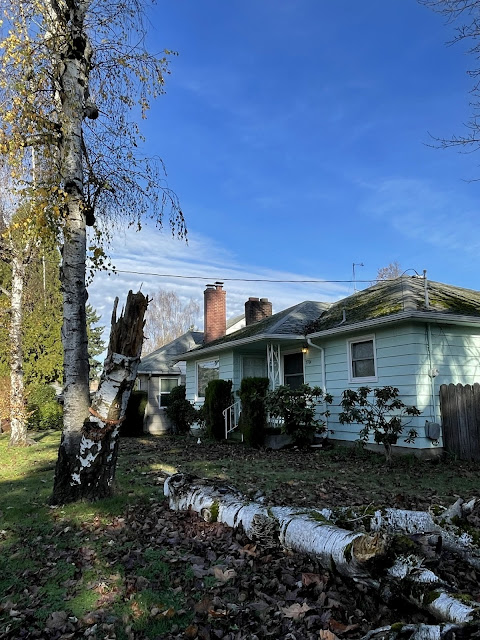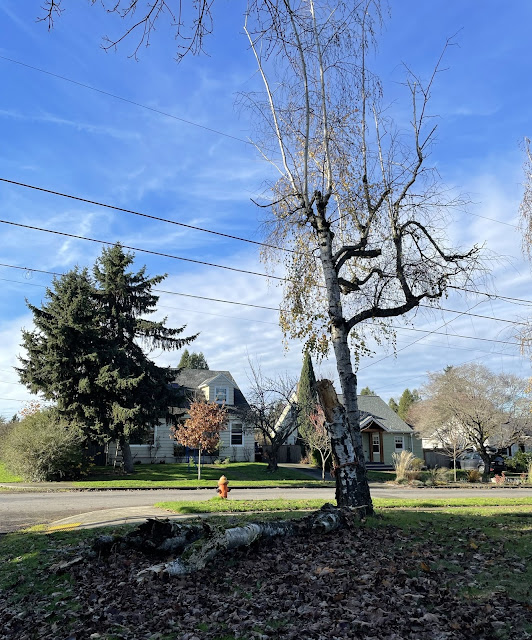All material © 2009-2021 by Loree Bohl for danger garden. Unauthorized reproduction prohibited and just plain rude.
Wednesday, December 8, 2021
If a turkey falls in the forest...
Andrew has mentioned more than once there is a certain kind of tree in the area that seem to all be dying, and appear to be hacked back into odd shapes. He's tentatively identified them as birch trees (*update, Roger Gossler confirms this and says it's Agrilus anxius, the bronze birch borer that's killing the trees*). On a recent walk we witnessed this fallen portion of one of these trees in a neighborhood yard.
That's not an insignificant section that broke off...
Thankfully it was only lawn below, to cushion the fall.
Our original walk had us passing by after dusk, when I happened to walk that way again a few days later I was stunned to see all the turkey-tail fungus and moss. There was this ruffled group...
And the more "common" stacked version.
I don't think I've ever seen such a dense grouping of different types of fungus on one tree (or part of a tree) before.
On the other side is what appears to be another species of fungus, and more moss.
If you're thinking I must be scheming on a way to drag these pieces of the fallen tree home and put them in my garden you'd be right. Wish me luck, I'm going to need it.
Subscribe to:
Post Comments (Atom)










At least the turkey-tail fungus offers some beauty to the lost tree. Those borers do a nasty job of killing trees - and, if they work like the shot-hole borers here, by the time they're noticed, it's generally too late to do anything to stop the damage.
ReplyDeleteYes, that's what Roger said about the bronze birch borer, it's terribly sad.
DeleteThat's exactly what I was thinking: how on earth is she going to get this thing home... I think you'll need Andrew and a power tool.
ReplyDeleteYa I kind of hoped the wood beneath the fungus would be in a state of decay and break apart, but that's not the case.
DeleteDr. Ed Hasselkus of UW-Madison and the UW Arboretum has worked on this issue. His White Satin birch is generally resistant. JF Schmidt Nursery says of this tree:" Selected by Dr. Ed Hasselkus of the University of Wisconsin, the original tree has resisted borers for nearly 30 years while nearby trees have died. Good cold hardiness, golden yellow fall color and satin-white bark are additional features of this long- lived, handsome tree." I believe introduced a couple of other resistant white birches.
ReplyDeleteWow, sounds like a winner!
DeleteTree probably dying for a while--poor sad tree, all it's beauty gone.
ReplyDeleteI wonder if you drag some pieces home you will be bringing some borers along with the pieces.
This thought did cross my mind. Although we have no birches and since the tree is only a couple of blocks away chances are there here already?
DeleteI have a theory on birch trees. I know there are native varieties, but I think these were brought by Scandinavian immigrants way back when - we're very sentimental about our birches. However, birches are thirsty trees. They can drink as much as 100 gallon per day. (In Sweden we make syrup out of the sap - it's very sweet.) Anyway, as we're getting increasingly hot and dry, any unwatered birches become weaker, and more and more susceptible to the borers. I constantly tell people to water their birches regularly if they intend to keep them. It seems to stave off the inevitable for a while, at least. Not very sustainable, though...
ReplyDeleteNo it's not, but trees are important investments. The ones Andrew has noticed dying are mostly street trees, lord knows those get even less water than the average "yard" tree and have to deal with all that extra heat.
DeleteAs beautiful as they are, birch trees are a poor choice as street trees in areas with hot and dry summers. I hope those responsible will act quickly to prevent property damage and plant suitable replacements. One can hope.
ReplyDeleteWe had our Birch borer event here several years ago - I went from 3n to 1. I was close to having the one left taken out but it has recovered and lives in an area where the soil is shades and doesn't dry out as fast as the rest of my garden. So for now it stays.
ReplyDeleteI love how nature recycles everything, nothing wasted. The turkey tails and moss are hard at work, breaking the deadwood down in the most beautiful of ways. Hope you score a log, I'm sure the owner will be happy for you to haul it away.
ReplyDelete